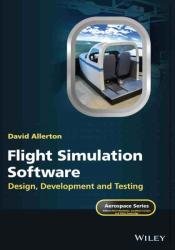 Название: Flight Simulation Software: Design, Development and Testing
Название: Flight Simulation Software: Design, Development and TestingАвтор: David Allerton
Издательство: Wiley
Год: 2023
Страниц: 510
Язык: английский
Формат: pdf (true)
Размер: 21.3 MB
Flight Simulation Software explains the many aspects of flight simulator design, including open source tools for developing an engineering flight simulator.
Flight simulation is an indispensable technology for civil and military aviation and the aerospace industry. Real-time simulation tools span across all aspects of aircraft development, from aerodynamics and flight dynamics to avionics and image generation systems. Knowledge of flight simulation software is vital for aerospace engineering professionals, educators, and students. Flight Simulation Software contains comprehensive and up-to-date coverage of the computer tools required to design and develop a flight simulator.
Written by a noted expert with decades of experience developing flight simulators in academia, this highly practical resource enables readers to develop their own simulations with readily available open source software rather than relying on costly commercial simulation packages. The book features working software taken from operational flight simulators and provides step-by-step guidance on software design, computer graphics, parallel processing, aircraft equations of motion, navigation and flight control systems, and more.
The challenge for the simulator developer, and the focus of this book, is to understand the techniques and methods used to design, develop and test software for an engineering flight simulator. The author’s knowledge and experience in developing software for flight simulation form the topics of the chapters of the book. All the software covered in the book is used in operational engineering flight simulators and is available from the publishers for free download. This software has run on Linux and Windows platforms for the PC and currently runs in real-time on Raspberry Pi computers.
This approach to software development is very much in line with the open systems community, where source code is made available to users who are encouraged to modify or improve the software, the associated libraries and support packages. The majority of the software in this book is written in the C programming language, increasing its portability for Windows and Linux platforms and extending its use to the many compatible libraries.
Chapter 1 covers the building blocks of simulators used in engineering design, particularly the concepts of real-time simulation, distributed computing and parallel processing. Chapter 2 provides a ‘software toolbox’ needed by most simulator developers, including data-fitting methods, the implementation of transfer functions and essential numerical methods. Chapter 3 covers the equations of motion, including axes systems, derivation of aerodynamic forces and moments and introduces the modelling of aircraft dynamics, engines and landing gear. Chapter 4 covers the design and testing of aircraft flight control systems including PID controller design and includes representative Airbus control laws. The principles and simulation of aircraft navigation systems including inertial navigation and satellite navigation systems are described in Chapter 5. The emphasis in Chapter 6 is on computer graphics, mostly illustrated with OpenGL examples, using modern graphics processing units (GPUs). Software is developed to emulate EFIS displays and traditional aircraft instruments. Image Generation (IG) systems are presented in Chapter 7 , which describes techniques used with visual databases and provides interfaces to use the renderers in OpenSceneGraph and X-Plane. Chapter 8 covers the use of synthetic sound generation, using the OpenAL API to generate the range of sounds required in flight simulation. The instructor operating station (IOS) is introduced in Chapter 9 and includes the design of user interfaces, map displays and flight data recording. Chapter 10 concludes with the validation of flight simulation software covering aircraft performance and dynamics and the modelling of linearised systems using Octave and outlines the procedures used in the qualification of airline flight simulators.
Explains both fundamental theory and real-world practice of simulation in engineering design
Covers a wide range of topics, including coding standards, software validation, user interface design, and sensor modelling
Describes techniques used in modern flight simulation including distributed architectures and the use of GPUs for real-time graphics rendering
Addresses unique aspects of flight simulation such as designing flight control systems, visual systems, and simulator instructor stations
Includes a companion website with downloadable open-source software and additional resources
Flight Simulation Software is a must-have guide for all developers and users of simulation tools, as well as the ideal textbook for relevant undergraduate and postgraduate courses in computer science, aeronautical engineering, electrical engineering, and mechanical engineering programs.
Скачать Flight Simulation Software: Design, Development and Testing